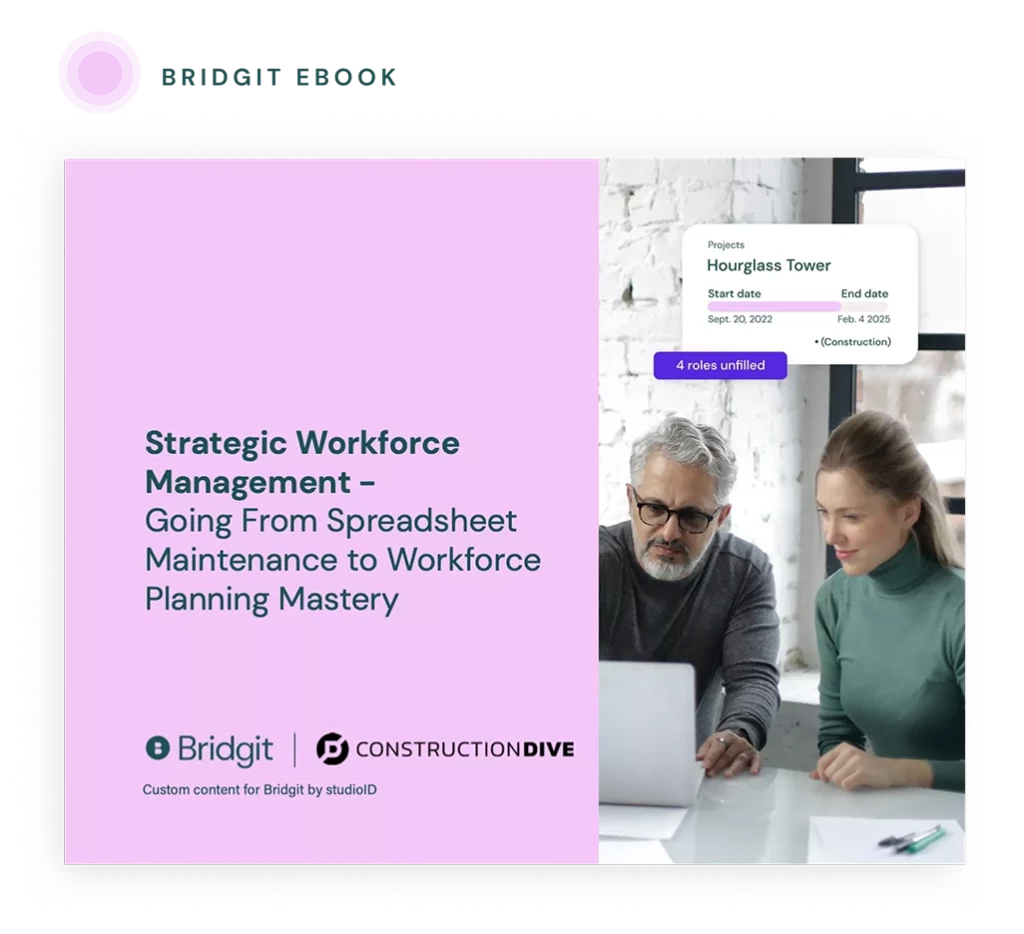You’re reviewing bid numbers for a $40M commercial project. Materials come in at $18M. Labor lands around $12M. The ratio looks reasonable, roughly in line with industry norms.
Table of Contents
But here’s what that split doesn’t tell you: one of those numbers you can influence, and one you mostly can’t.
Material costs move with global commodity markets, trade policy, and supply chains you don’t control. Steel prices jumped 25% in early 2025 when new tariffs took effect. Copper fluctuates with mining output in Chile. Lumber tracks housing starts and Canadian trade negotiations. You can time purchases, lock in pricing, and negotiate with suppliers, but the baseline costs are largely set by forces outside your office.
Labor is different. Labor costs are a function of decisions you make every week: who you staff, how you schedule, whether you’re carrying the right mix of experience for the work at hand. That’s what makes labor the controllable cost in construction—and why understanding the split matters more than just knowing the numbers.
Labor vs material cost breakdown by project type
Labor and material ratios vary significantly depending on what you’re building. A warehouse shell with repetitive structural work looks nothing like a hospital with complex MEP coordination. Industry cost data shows labor typically runs 20-40% of total project cost, with materials comprising 45-55% depending on project type.
| Project type | Labor share | Material share | Why it varies |
|---|---|---|---|
| Warehouse / industrial shell | 20-30% | 50-60% | Repetitive work, simple systems, high prefab potential |
| Commercial office | 25-35% | 45-55% | Standard systems, moderate complexity |
| Multifamily residential | 30-40% | 40-50% | Finish work drives labor; unit repetition helps |
| Healthcare / lab | 35-45% | 40-50% | Complex MEP, commissioning, specialized trades |
| Renovation / tenant improvement | 40-50% | 30-40% | Selective demo, phasing, existing conditions |
Sources: Industry cost breakdowns from Revizto and Buildern. Ranges reflect typical U.S. commercial construction.
The remaining 15-25% covers general conditions, equipment, fees, and contingency.
These ranges reflect typical cost structures, not targets. A 35% labor share isn’t better or worse than 25%—it reflects project complexity and trade mix. What matters is whether your labor costs are appropriate for the work and whether you’re getting the productivity you planned for.
Regional differences compound the variation. According to the Construction Labor Research Council’s 2025 report, union labor in the Northeast averages $77/hour total package rate; the same trades in the South average $50/hour—a 54% gap. A project that pencils in Atlanta looks different in Boston, even with identical scope.

Looking to be more strategic with your people?
We partnered with Construction Dive to outline the steps any contractor can take to be more strategic with their workforce management.
Why construction labor costs are manageable (and material costs aren’t)
Materials arrive on site at prices set by markets. Your influence is limited to procurement timing, supplier relationships, and specification choices made during design. Important, but bounded.
Labor costs respond to decisions you make continuously throughout a project. This is what makes labor the controllable variable. Not because you can change wage rates or ignore union agreements, but because you control who works on what, when they start, and how long they stay. Those decisions compound across dozens or hundreds of projects into measurable margin differences between firms working in the same market with the same cost structure.
Staffing choices. Putting a senior PM on a straightforward tenant improvement means you’re paying for experience you don’t need. Putting a junior PM on a complex healthcare project means you’ll pay in rework, RFIs, and schedule delays. The right match between project needs and team capability is the single biggest lever you have on labor cost. This isn’t about finding cheaper people. It’s about matching expensive expertise to projects that justify it and developing less expensive talent on projects where they can succeed without creating risk.
Utilization management. An idle superintendent costs $2,500/week whether they’re producing or not. Multiply that across a portfolio with uneven project timing and gaps between assignments, and underutilization becomes a significant margin leak. Contractors who track utilization systematically—knowing who’s available, when projects need people, and where gaps are forming—avoid the carrying costs of bench time.
Team composition. A project needs a certain amount of experience, but not uniformly distributed. Pairing a veteran superintendent with a capable but less experienced PM often outperforms two mid-level leaders. Getting the mix right means you’re not overpaying for seniority where it isn’t needed.
Schedule efficiency. Labor costs compound when schedules slip. Crews stay on site longer. Overtime kicks in. Indirect costs accumulate. A two-week delay on a $30M project can add $200K in labor costs before you account for liquidated damages or downstream trade impacts.
Here’s a concrete example. Two similar office projects, same market, same GC. Project A staffs a senior PM who’s run fifteen similar jobs. Project B staffs a PM with strong skills but no experience in this building type. Both projects finish. Project A comes in at 28% labor share. Project B comes in at 34%—six points higher, driven by slower RFI resolution, two resequencing episodes, and a punch list that took three weeks instead of one. Same scope. Same market rates. Different outcomes based on a staffing decision made before ground broke.
Construction labor and material cost trends in 2025
Both labor and materials are under pressure, but from different sources.
| Cost driver | 2025 impact | Source |
|---|---|---|
| Steel tariffs | +25% on imports (effective March 2025) | NAHB |
| Aluminum tariffs | +25% on imports | NAHB |
| Overall material costs | +9% through mid-2025 | Cushman & Wakefield |
| Skilled labor wages | +4% YoY average | CLRC 2025 |
| Labor availability | 439,000 workers needed in US | ABC/AGC |
Material costs are spiking on specific commodities. Steel and aluminum tariffs added 25% overnight for imported product. Domestic suppliers raised prices to match. Contractors report 9% overall material cost increases through mid-2025, with metals hit hardest.
Labor costs are rising more steadily—about 4% annually—but the pressure is structural rather than cyclical. The industry needs 439,000 new workers just to meet current demand. That shortage shows up as wage pressure in hot markets and as schedule risk when you can’t find the trades you need. The gap is widening. Retirements continue to outpace new entrants, particularly in skilled trades. Electrical, plumbing, and HVAC contractors report multi-week delays just to start work, which cascades into general contractor schedules and drives labor costs up as crews wait or work out of sequence.
Looking into 2026, both trends are expected to persist. Material costs may stabilize if tariff policy clarifies, but there’s no relief expected on labor. Demographic pressure continues. The workforce is aging, and recruitment hasn’t kept pace. This means labor costs will likely continue their steady climb even as material costs normalize—making workforce planning and utilization management increasingly important levers for protecting margins.
The interaction matters. Material cost spikes often trigger schedule acceleration to lock in pricing, which strains labor availability and drives overtime. Tariff uncertainty makes procurement timing more critical, which puts more pressure on planning accuracy—which depends on knowing who will be available when.
The 2025 State of Workforce Planning report found that 93% of construction leaders say labor shortages are impacting operations. That pressure translates directly to costs: overtime premiums, retention bonuses, productivity losses from inexperienced crews, and the invisible cost of projects you don’t bid because you can’t staff them.
How to calculate and control construction labor costs
Given that labor is the controllable cost, what does control actually look like? It comes down to three capabilities: visibility, forecasting, and matching.
Visibility means knowing, in real time, who is working on what, when they’ll be available, and how utilized your workforce actually is. Most contractors operate with partial information—one person who knows the staffing picture, updated weekly if you’re lucky, stored in a spreadsheet that’s already out of date. That information gap translates to reactive decisions: scrambling to staff projects that are already starting, carrying people longer than necessary because you didn’t see the next assignment coming.
Forecasting means looking at your project pipeline—pursuits, awards, active work—and projecting labor demand against labor supply. Not just for next month, but for the next year or two. When will you have capacity gaps? When will you be overstaffed? Which pursuits should you chase based on whether you can actually staff them if you win?
This kind of analysis requires connecting your workforce data to your project data. The Bridgit Forecasting Dashboard does exactly this—showing supply and demand across your portfolio with scenario planning for pursuits still in the pipeline.
Matching means putting the right people on the right projects. Not just who’s available, but who’s qualified. Who has experience with this building type? Who has worked with this architect before? Who works well with the superintendent you’ve already assigned?
| Capability | What it enables | What it prevents |
|---|---|---|
| Real-time visibility | Proactive staffing decisions | Scrambling, double-booking, bench time |
| Demand forecasting | Strategic hiring, confident bidding | Reactive hiring cycles, capacity surprises |
| Experience matching | Right-fit teams, faster ramp-up | Mis-staffing, learning curve costs |
Experience-based matching requires data you probably don’t have in a spreadsheet: project history, build types, client relationships, who has worked together before. Internal Resumes capture this systematically—so when you’re staffing a hospital project, you can find everyone who’s worked on healthcare, not just who you happen to remember.
The contractors who manage labor costs effectively aren’t working harder. They’re working with better information: real-time visibility, forward-looking forecasts, and experience data that turns staffing from a gut-feel exercise into a structured decision.
Managing construction costs: what you can actually control
The labor/material split tells you something about project complexity. But it doesn’t tell you what you can actually do about costs.
Materials will keep moving with global markets. Tariffs may expand or ease. Commodity prices will fluctuate. You’ll manage that through procurement strategy, specification choices, and supplier relationships—real levers, but bounded ones.
Labor costs are different. They’re shaped by staffing decisions, utilization management, and how well you match people to projects. Those aren’t market forces. They’re operational choices.
The contractors pulling ahead on margins aren’t finding cheaper labor or cutting corners on experience. They’re getting more deliberate about how they deploy the workforce they have—tracking utilization, forecasting demand, and matching experience to project needs instead of just filling slots with whoever’s available.
That’s what controllable costs actually means. Not that the number is fixed, but that the outcome depends on decisions you make.ed labor needed to manipulate these materials effectively.
Bridgit Bench is a leading construction resource management application
We hope you’ve found this article helpful for understanding the breakdown between construction labor costs vs material costs. Learn more about how Bridgit Bench helps construction companies calculate and track resource costs and usage. For more of our articles on the topic of construction resource management, visit the Bridgit blog.


